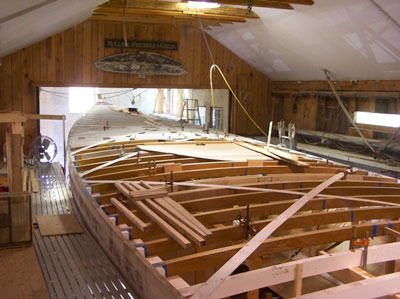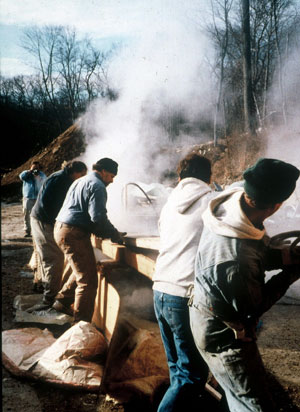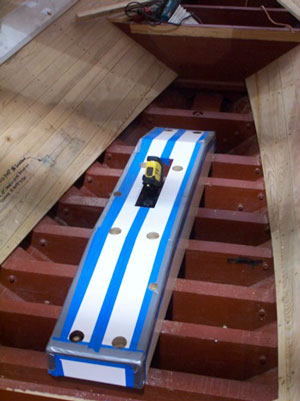Modern materials

We practice traditional boatbuilding. We usually prefer to use the same materials which were used originally, and we often go to great lengths to obtain them. However, in cases where modern materials are clearly better, we have developed innovative ways to use them without sacrificing the modular construction concepts inherent in traditional boatbuilding.
We do use adhesives to a greater extent than they were used in the original construction. Our main use of adhesives is to eliminate potentially troublesome joints in individual components, not to attach components to each other. However, we retain the modular character of the original construction that allows replacement of individual components in case of damage. For example, we will use epoxy to scarf a plank into a full-length piece to eliminate butts, but we would never glue the plank to the frames or to the adjacent planks.
Steam bending

We use steam bending extensively, and we rarely laminate structural members. By carefully studying old hulls we have defined the requirements for bending stock and the limits on the severity of bends; we feel that most structural failures of bent components in older boats are due to a failure to observe these requirements and limits. We have developed procedures for predicting the elastic springback of bent timbers, along with the computer software to implement it. These techniques allow us to take advantage of the efficiency of steam bending and the longevity and strength of steam-bent parts in repair and restoration situations where laminating has become commonplace.
Painting
We believe in painting as a construction technique. That is, the extensive use of paint during, not just after construction. The places where paint and varnish can have the greatest effect in prolonging a boat’s life and in decreasing regular maintenance requirements are often inaccessible once the structure is complete. We paint every wood-to-wood and wood-to-metal joint before assembly. We are especially careful to coat end-grain surfaces during construction. Our experience has shown conclusively that the extra cost of painting during assembly is recovered quickly and many times over in longer lifetimes for structural members and decreased maintenance costs over the years.
Restoration of strength
We place heavy emphasis on restoring boats not just to the way they looked when new, but to the strength they had when they were new. Since many of the lightly constructed sailboats we work on come to us with structural problems in the mast step area, we have studied these problems in depth and have coh2e up with a number of techniques for reinforcing boats against rig forces. A lot of our efforts in structural re-engineering are to correct structural deficiencies around mast steps.
Restoration of shape
Many old boats have lost their sheer or transverse shape due to deformation over the years. On all major restoration projects, we take great pains to restore the hull to its original shape, rather than just replacing parts. Over the years we have developed a number of techniques for truly restoring, not just rebuilding, wooden boats. Our major projects go out the door with a proper sheer line, a straight waterline, and a fair hull.
Restoration of watertight integrity
Most of the boats we work on come to us with leaking problems, sometimes severe. Many boats have expanded in girth due to broken frames or deformations in the mast area, and many have planks that have been damaged by compressive set, overcaulking, or the use of hard seam putty. Our restoration techniques re-establish the tightness of the planking before it is recaulked, whether the planking is original or new, thus giving boats a fresh start with a tight hull.
Double planking
We have researched the techniques of the Herreshoff Mfg. Co. and have carefully studied the planking techniques used in their larger boats. Based on this information we have developed a very efficient double-planking technique that we believe closely follows what was used at herreshoff.
Special fastenings

Herreshoff and Nevins used flat-head fin-neck bolts instead of the round-head square-neck carriage bolts that are now in common use. We feel that the fin-neck bolts are superior to common carriage bolts in many cases, especially when the heads are bunged in lightly constructed boats. We have silicon bronze flat-head fin-neck bolts custom-made for our own use and we also offer them for sale to other builders at costs competitive with carriage bolts.
Herreshoff used hanger bolts with a special buttress thread as ballast bolts on boats up to the largest wood boats they built. Hanger bolts not only save on materials, but they greatly simplify to process of mating a boat to its ballast. We have developed a series of buttress-thread hanger bolts similar in proportion to those used by herreshoff, and we have the facilities to make them efficiently both for our own use and for sale to other builders.
Shear connectors
We have
pioneered the use of split-ring and slug-type shear connectors
for important structural wood-to-wood joints in boat construction. These
connectors have been used extensively for years in heavy-timber building and
bridge construction, but they have not caught on in high-quality boatbuilding
despite their many structural advantages because they were not available in
suitable sizes and materials. We have developed the hardware, the tooling, and
the techniques to use them. This is another example of an old and time-tested
technique that we have adapted to a new use.
Scarfed planks
Where glued-scarf construction offers advantages over traditional pieced-up construction, we have designed and built a number of special jigs for scarfing planks and for using scarfed graving pieces to restore the strength of old planks rather than just plugging the holes. In many of our major restorations we eliminate plank butts entirely, for a lighter, stronger, more watertight and longer lasting planking job.
